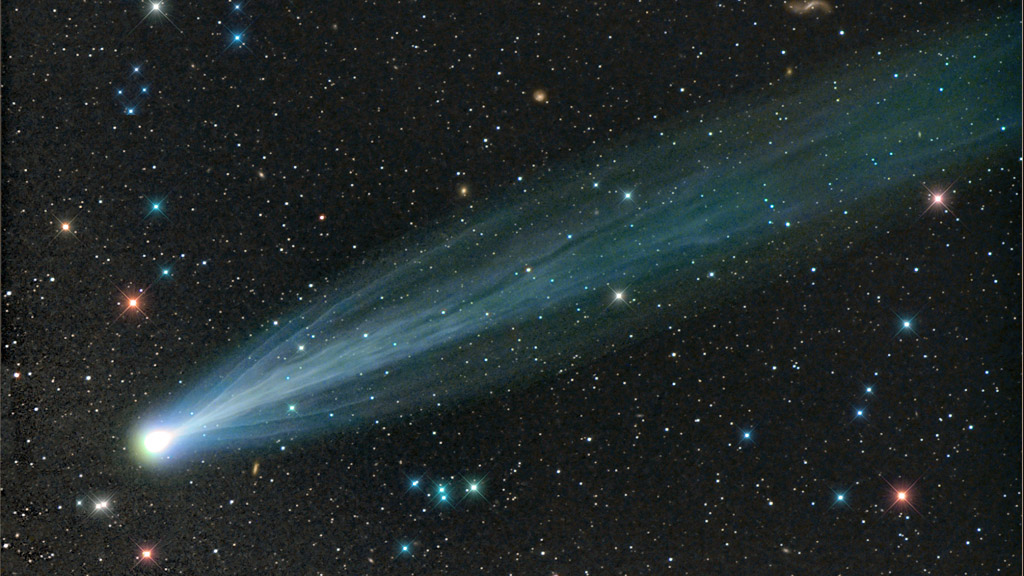Will Comet Ison light up the skies above earth?
Ison, one of the brightest comets ever, is passing above us. It promises unique insights into the history of our planetary neighbourhood – though the full moon may obscure its visibility.

(image courtesy Damian Peach)
If you get up very early on Tuesday morning and know precisely where to look, you might just catch a glimpse of Comet Ison as it hurtles towards the sun.
According to the hype, Ison was going to be an astronomical marvel. Billed as one of the most visible comets ever to grace our skies – brighter than the full moon itself. But it’s turned out to be a lot trickier to see than that.
While Ison has got suddenly brighter as it approached the sun, nature has thown up some fairly immovable obstacles for observers here on earth.
The comet’s arrival has coincided with a full moon, and it is only visible for an hour or so before the night gives way to day. “It’s a very diffuse object, and with the moon in the way it’s been very hard to see,” said Mike Meynell, chair of the Flamsteed Society, an amatuer astronomy group based in London.
The comet is visible in the eastern sky at around 5am. Since it became bright enough to see with the naked eye a few days ago, cloudy starts across most of Britain have also made it very hard to spot.
Hard to see
And now it’s getting very close to the sun – its closest approach, or perihelion, is 28 November. It will get inceasingly hard to see. Given the expected observing conditions in Britian, most amateur astronomers are holding out little hope: “I think it’s unlikely now there’s any chance of seeing it before perihelion,” Meynell told Channel 4 News.
Some British astronomers have had success, however. Renowned amateur astrophotographer Damian Peach obtained the image at the top of the page – one of the most impressive ground-based images of the comet – from his home in Kings Lynn.
We think this is Ison’s first journey around the sun. We don’t really know what to expect. Dr Marek Kukula, Royal Observatory
Hopes now rest on seeing the comet as it appears from behind the sun in early December. The heat from the sun will cause more of the comet’s icey surface to boil off, making it more visible still.
But its brush with our star could either be the making of Ison, or its undoing.
“We think this is Ison’s first journey around the sun,” said Dr Marek Kukula, public astronomer at the Royal Observatory in London. “We don’t really know what to expect.”
Unique insights
There is a good chance Ison, which is traveling at 234 miles a second, could simply break up and disappear on its closest approach to the sun. Its journey takes it to within 720,000 miles of the sun, which will heat it to 2700 degrees centigrade.
This process will be of intense interest to astronomers. Like all comets, Ison is made of the same simple ingredients that first formed our solar system. If this is its first passage around the sun, it will be pristine and could give unique insights into the history of our planetary neighbourhood as it is vaporised.
Scientists have already pointed space telescopes like Hubble and comet-watching probe Messenger at Ison to study the chemical signatures it throws out.
“Either way, it’s going to be a very interesting comet. It just might not be a very impressive object to the naked eye,” says Dr Kukula.
-
Latest news
-
Taylor Swift’s new break-up album breaks records3m

-
NHS trust fined £200K for failings that led to death of two mental health patients3m

-
Sunak vows to end UK ‘sick note culture’ with benefit reform3m

-
‘Loose talk about using nuclear weapons is irresponsible and unacceptable’, says head of UN’s nuclear watchdog3m

-
‘There wasn’t an Israeli attack on Iran,’ says former adviser to Iran’s nuclear negotiations team7m

-




